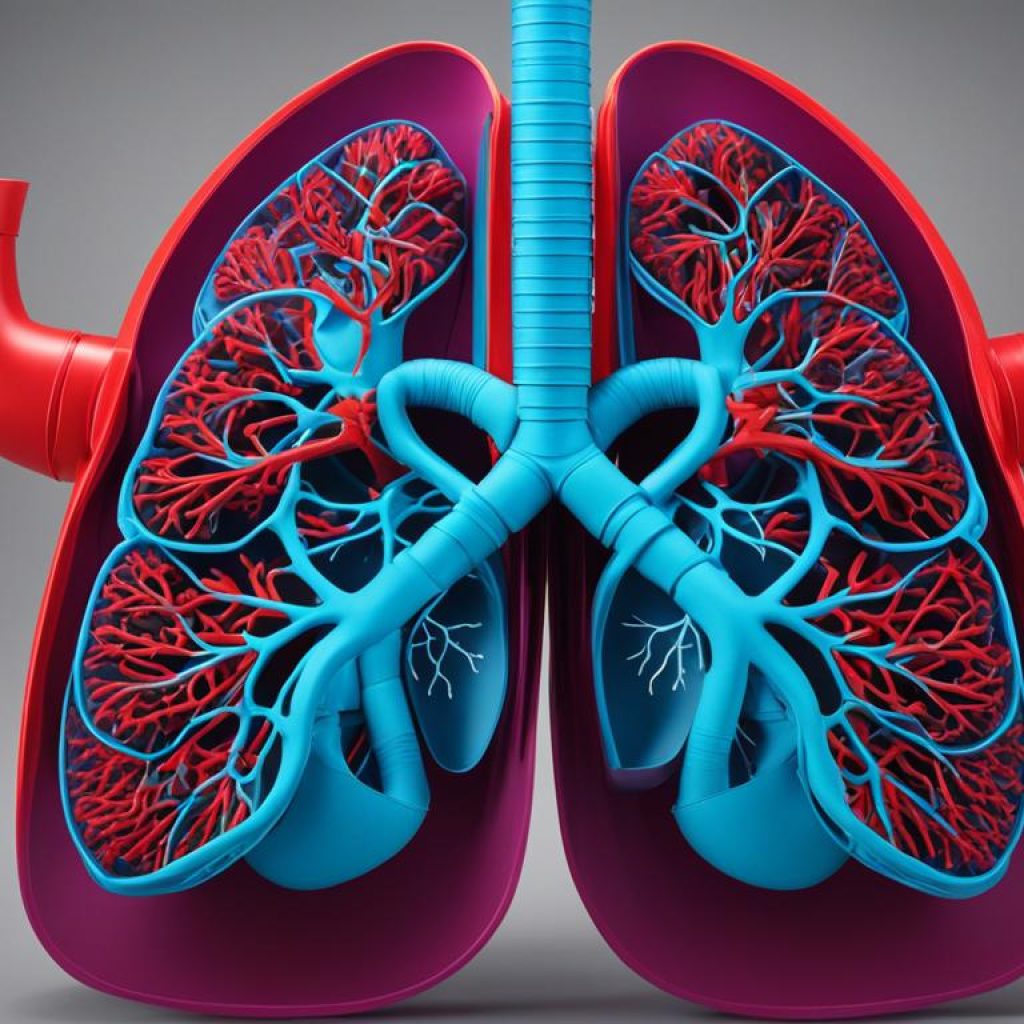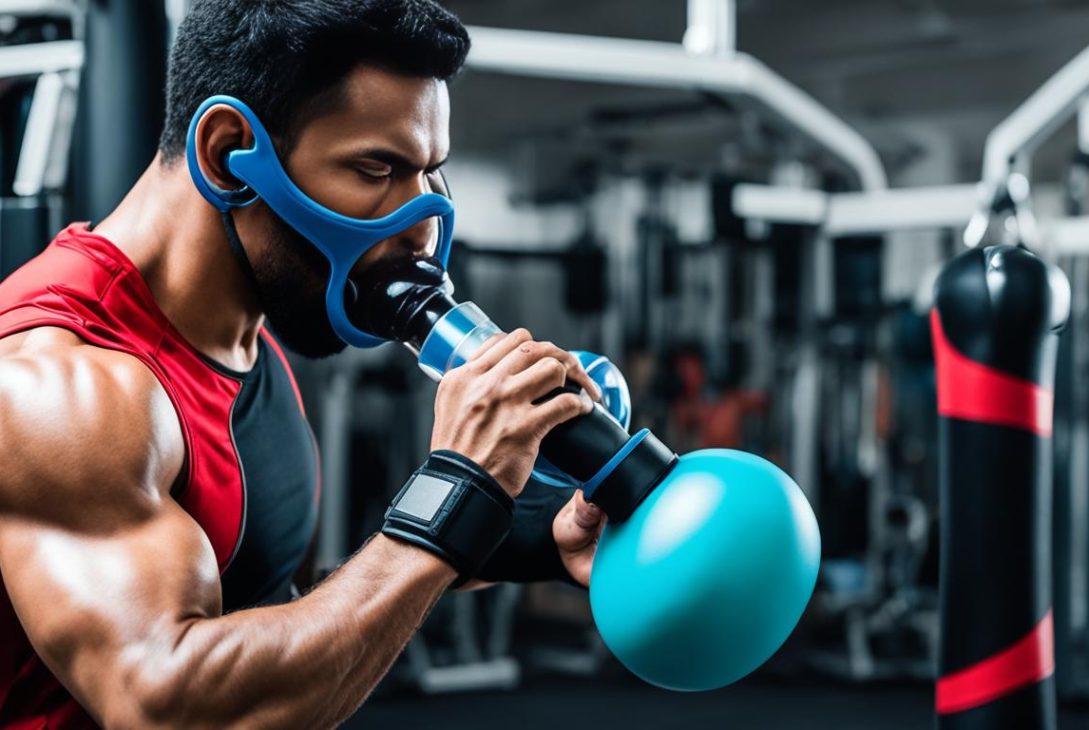If you’re an athlete in combat sports, such as boxing, MMA, or Muay Thai, you understand the importance of having strong lungs and respiratory fitness. Effective breathing techniques and optimal lung capacity can significantly enhance your fight and sparring performance. One way to improve your lung capacity and respiratory function is through the use of breathing trainers. In this article, we will explore how breathing trainers work, their benefits, and how to integrate them into your training regimen.
Key Takeaways:
- Boosting lung capacity is crucial for better performance in combat sports.
- Breathing trainers are devices designed to strengthen respiratory muscles and expand lung volume.
- Using breathing trainers can improve lung function, endurance, and overall breathing mechanics.
- Choosing the right breathing trainer and integrating it into your training regimen is essential.
- Tailoring breathing exercises to your workout intensity can enhance performance in high-intensity sparring sessions and aid in recovery.
- Advanced techniques, such as diaphragmatic breathing and resistance training, can further increase respiratory function.
- Maintaining respiratory health through proper nutrition, lifestyle choices, and stress management is vital for long-term success.
Understanding Lung Capacity and Its Importance in Combat Sports
In combat sports, such as boxing, MMA, or Muay Thai, lung capacity plays a vital role in determining an athlete’s performance. To excel in these high-intensity sports, fighters must optimize their lung function and ensure respiratory health. This section will explore the concept of lung capacity, its significance in combat sports, and the impact of respiratory health on overall athletic performance.
What Is Lung Capacity?
Lung capacity refers to the total volume of air that the lungs can hold. It is measured in terms of the maximum amount of air that can be inhaled and exhaled during a complete breath. A person’s lung capacity is determined by various factors, including age, sex, height, and overall health.
Why Lung Capacity Matters for Fighters
In combat sports, fighters need to perform at their peak for extended periods. Having larger lung capacity allows fighters to take in more oxygen, which is essential for powering their muscles and maintaining endurance. With greater lung capacity, fighters can sustain high levels of physical exertion without experiencing fatigue and lack of breath, giving them a competitive advantage in the ring.
The Impact of Respiratory Health on Athletic Performance
Respiratory health directly influences overall athletic performance. Poor lung function can limit an athlete’s ability to deliver oxygen to their muscles efficiently, resulting in decreased speed, reduced power output, and early fatigue. On the other hand, athletes with well-maintained respiratory health can achieve optimal oxygen uptake, enhancing their endurance, stamina, and overall athletic capabilities.
The Science Behind Breathing Trainers
Breathing trainers are devices specifically designed to strengthen the respiratory muscles and expand lung volume. They typically employ resistance-based techniques to stimulate the diaphragm, intercostal muscles, and other respiratory muscles. By using these trainers regularly, fighters can improve their lung capacity, respiratory efficiency, and overall breathing mechanics.
Research has shown that breathing exercises can effectively enhance lung function, improve respiratory muscle strength, reduce breathlessness, and increase exercise tolerance. These evidence-based benefits make breathing trainers a valuable tool for fighters looking to optimize their respiratory fitness and improve their performance in combat sports.
One of the key benefits of breathing exercises is their ability to expand lung volume. By using resistance-based trainers, fighters can gradually increase the workload placed on their respiratory muscles, leading to improved strength and endurance. This expansion of lung volume allows for a greater intake of oxygen during physical activity, enhancing overall athletic performance.

Additionally, breathing exercises can improve respiratory efficiency by teaching fighters how to breathe more effectively. Proper breathing mechanics ensure that oxygen is delivered efficiently to the muscles, reducing the energy expenditure required for respiration. This can result in increased endurance, decreased fatigue, and improved overall performance during fights and sparring sessions.
Overall, the science behind breathing trainers and the benefits of breathing exercises demonstrate their importance in combat sports. By incorporating these tools into their training regimens, fighters can enhance their lung capacity, optimize their respiratory fitness, and ultimately, improve their fight performance.
Choosing the Right Exerciser to Strengthen Lungs
When it comes to strengthening your lungs, selecting the right breathing exerciser is crucial. Consider your goals, fitness level, and personal preferences before making a decision. There are different types of breathing trainers available, each targeting specific aspects of respiratory fitness and offering unique benefits.
One type of breathing trainer is the inspiratory muscle trainer, which focuses on strengthening the muscles involved in inhalation. This type of trainer helps improve lung capacity and respiratory efficiency.
Another option is the respiratory muscle trainer, which targets both the inspiratory and expiratory muscles. This trainer provides resistance during both inhalation and exhalation, helping to enhance overall respiratory function.
Incentive spirometers are another popular choice. These devices encourage deep breathing and help expand lung volume. They are often used post-surgery or for respiratory rehabilitation.
To select the right exerciser for your needs, it’s recommended to consult with a healthcare professional or fitness expert. They can assess your specific requirements and guide you towards the most suitable option.
Choosing the right breathing exerciser is a vital step in improving your lung strength and respiratory fitness. By selecting the appropriate trainer, you can effectively target the specific muscles involved in respiration and achieve optimal results.
Integrating Breathing Trainers into Your Training Regimen
To maximize the benefits of breathing trainers and enhance your respiratory fitness, it is essential to integrate them effectively into your training regimen. By following best practices for using lung training devices and creating a consistent breathing exercise program, you can optimize your results and track your progress.
Best Practices for Using Lung Training Devices
When using breathing trainers or lung training devices, it is crucial to adhere to the following best practices:
Maintain Proper Posture: Sit or stand upright with good posture during breathing exercises. This allows for optimal respiratory muscle engagement and airflow.
Use the Correct Resistance Levels: Start with a comfortable resistance level and gradually increase it over time as your respiratory muscles become stronger. Avoid starting with high resistance, as it may cause fatigue or strain.
Focus on Breathing Technique: Pay attention to your breathing technique while using the trainer. Breathe deeply, engaging your diaphragm, and exhale fully to maximize lung expansion and contraction.
Be Consistent: Incorporate breathing trainers into your training routine regularly, ideally several times a week. Consistency is key to achieving long-term improvements in lung capacity and respiratory fitness.
Creating a Consistent Breathing Exercise Program
To track your progress and achieve optimal results with your respiratory fitness, it is essential to develop a consistent breathing exercise program. Consider the following when creating your program:
Set Specific Goals: Determine your specific respiratory fitness goals, such as increasing lung capacity or improving breath control during fights. Having clear goals will help you tailor your breathing exercises accordingly.
Incorporate Specific Techniques: Explore different breathing techniques, such as diaphragmatic breathing or pursed lip breathing, and include them in your program based on their benefits and relevance to your goals.
Determine Duration and Frequency: Decide on the duration and frequency of your breathing exercises. Start with shorter durations and gradually increase them as you progress. Aim for consistency rather than pushing yourself too hard initially.
Track Your Progress: Keep a record of your breathing exercise sessions and monitor any improvements in lung capacity, breath control, or overall respiratory fitness. This tracking will help you assess the effectiveness of your program and make any necessary adjustments.
Tailoring Breathing Exercises to Your Workout Intensity
As a fighter, your training intensity may vary from high-intensity sparring sessions to recovery periods post-fight. It’s essential to tailor your breathing exercises accordingly to match the demands of your workouts. For high-intensity sparring sessions, implementing specific breathing techniques, such as interval training with breathing trainers, can help simulate real fight scenarios and enhance your performance. On the other hand, recovery breathing techniques can aid in relaxation, reducing stress, and promoting faster recovery between training sessions and fights.
Adapting Exercises for High-Intensity Sparring Sessions
During high-intensity sparring sessions, it’s crucial to optimize your breathing to support your performance and endurance. Implementing interval training with breathing trainers can be an effective strategy. This involves alternating between periods of high-intensity sparring and short rest intervals, utilizing the breathing trainer to regulate your breathing pattern and maximize your lung capacity. By training your body to adapt to the demands of intense fights, you can improve your overall stamina, enhance your oxygen delivery, and maintain a competitive edge.
Recovery Breathing Techniques Post-Fight
After an intense fight or training session, recovery breathing techniques play a vital role in helping your body recover and reset. These techniques focus on deep breathing, allowing your body to relax, reduce stress levels, and promote faster recovery. As you engage in controlled breathing exercises, you facilitate the removal of waste products like carbon dioxide and replenish your oxygen levels, aiding in the repair and regeneration of your muscles. Incorporating recovery breathing techniques into your post-fight routine can enhance your recovery process, minimize muscle soreness, and prepare you for the next training session or fight.
| Benefits of Adapting Breathing Exercises for High-Intensity Sparring Sessions |
|---|
| Enhanced lung capacity and oxygen intake |
| Improved stamina and endurance during fights |
| Better regulation of breathing pattern and rhythm |
| Increased competitiveness and performance |
Advanced Techniques to Increase Respiratory Function
In addition to using breathing trainers, there are advanced techniques that fighters can incorporate to further increase their respiratory function. These techniques focus on improving lung capacity and strengthening the respiratory muscles.
Incorporating Diaphragmatic Breathing
One advanced technique is diaphragmatic breathing, also known as belly breathing. This technique involves engaging the diaphragm to take deeper and more efficient breaths. By consciously using the diaphragm, fighters can expand their lung capacity and improve their ability to manage breathing patterns during fights. Diaphragmatic breathing can be practiced both during training sessions and in everyday life to enhance respiratory function.

Resistance Training for the Respiratory System
Another advanced technique for increasing respiratory function is resistance training for the respiratory system. This form of training involves breathing against resistance devices or using pursed lip breathing techniques. By challenging the respiratory muscles, resistance training can strengthen them over time, leading to improved breathing efficiency and endurance. Incorporating resistance training into a comprehensive training regimen can provide fighters with a competitive edge in combat sports.
| Advanced Techniques for Increasing Respiratory Function | Benefits |
|---|---|
| Diaphragmatic Breathing |
|
| Resistance Training for the Respiratory System |
|
Lung Strengthening Equipment Beyond Breathing Trainers
While breathing trainers are effective tools for improving lung capacity, there are additional equipment and practices that can enhance respiratory fitness. Incorporating lung strengthening equipment into your training regimen can further optimize your respiratory health and improve your overall performance in combat sports.
Additional Tools for Enhancing Respiratory Fitness
Power lung trainers are one such option that can help strengthen your lungs. These devices provide resistance during inhalation and exhalation, forcing your respiratory muscles to work harder and become stronger over time. By regularly incorporating power lung trainers into your training routine, you can increase your lung capacity and improve your respiratory efficiency.
Another tool that can be beneficial is an altitude training mask. These masks simulate training at high altitudes, where the air is thinner and oxygen levels are lower. By wearing an altitude training mask during your workouts, you can challenge your lungs to adapt to reduced oxygen levels, improving their efficiency and oxygen-carrying capacity.
These additional tools can be used alongside breathing trainers to further enhance your respiratory fitness and support optimal lung function.
Complementary Practices for Lung Health
In addition to using equipment, incorporating complementary practices into your training regimen can also contribute to lung health and overall respiratory fitness.
Yoga, for example, focuses on deep and controlled breathing, helping to strengthen the respiratory muscles and improve lung capacity. Regular practice of yoga can enhance your breath control, increase your lung efficiency, and promote overall respiratory health.
Meditation is another complementary practice that can benefit your lungs. By focusing on deep, rhythmic breathing during meditation sessions, you can calm your mind, reduce stress, and promote relaxation. This can help improve your overall breathing efficiency and enhance your ability to control your breath during fights or intense training sessions.
Aerobic exercises, such as running or cycling, can also be beneficial for lung health. These activities increase your heart rate, improve cardiovascular fitness, and challenge your respiratory system to deliver oxygen to your muscles efficiently. By incorporating regular aerobic exercises into your training routine, you can strengthen your lungs and enhance your endurance.
By combining lung strengthening equipment with complementary practices, you can optimize your respiratory fitness, improve your lung capacity, and enhance your overall performance in combat sports.
Measuring Improvements in Lung Capacity and Fight Performance
To evaluate the effectiveness of your lung training program and its impact on fight performance, it’s essential to measure your improvements in lung capacity and respiratory fitness. One way to track your progress is by using lung conditioning tools such as spirometers and peak flow meters. These devices provide objective measurements of your lung capacity, allowing you to monitor your growth over time.
Lung capacity is a crucial metric to consider when assessing your respiratory fitness. By measuring the amount of air your lungs can hold, you can gauge the effectiveness of your training and identify areas for improvement. Regular use of lung conditioning tools enables you to track changes in your lung capacity and determine whether your training program is helping you achieve your goals.

“The use of spirometers and peak flow meters provides quantifiable data that paints a clear picture of your progress. These tools allow you to assess not only your lung capacity but also your respiratory efficiency. By tracking these metrics, you can make adjustments to your training regimen and ensure you’re on the right path to success.” – Dr. Samantha Stevens, leading sports performance specialist
In addition to measuring lung capacity, there are other benchmarks for success in respiratory fitness that you can use to evaluate your fight performance. These benchmarks include:
- Increased time to exhaustion: A longer duration of exercise without feeling excessively breathless indicates improved respiratory fitness.
- Reduced breathlessness during exercise: If you can perform intense physical activity with less shortness of breath, it signifies enhanced respiratory function.
- Improved recovery rates: The ability to recover quickly between intense training sessions or fights demonstrates better overall lung function and resilience.
By actively tracking your progress and using these benchmarks, you can assess the effectiveness of your training program and make informed adjustments to optimize your fight performance.
| Metrics | Benchmarks |
|---|---|
| Increased time to exhaustion | Longer duration of exercise without excessive breathlessness |
| Reduced breathlessness during exercise | Ability to perform intense physical activity with less shortness of breath |
| Improved recovery rates | Quick recovery between intense training sessions or fights |
Tracking your progress and having clear benchmarks helps you stay motivated and focused on achieving your goals. By consistently measuring your improvements in lung capacity and respiratory fitness, you can stay on track with your training regimen and continue striving for success in combat sports.
Maintaining Respiratory Health for Long-Term Athletic Success
To ensure long-term athletic success and optimize respiratory health, it is crucial for fighters to pay attention to their nutrition and lifestyle choices. Proper nutrition, combined with a balanced diet rich in macronutrients and micronutrients, can significantly support lung health and overall respiratory function. Additionally, certain lifestyle habits and environmental factors can greatly impact respiratory health.
Nutrition and Lifestyle Choices Affecting Lung Health
The food we consume plays an essential role in maintaining respiratory health. Including foods that are rich in antioxidants, vitamins, and minerals can benefit lung function. Some nutrient-dense foods that promote lung health include:
- Dark leafy greens: Spinach, kale, and Swiss chard are packed with antioxidants and essential vitamins that support lung health.
- Fatty fish: Fish such as salmon, tuna, and sardines are high in omega-3 fatty acids, which have anti-inflammatory properties and may help reduce the risk of lung diseases.
- Colorful fruits and vegetables: Bell peppers, berries, citrus fruits, and tomatoes are excellent sources of antioxidants and vitamins that enhance lung function.
- Whole grains: Consuming whole grain products like brown rice, quinoa, and whole wheat bread provides essential nutrients, fiber, and antioxidants that benefit overall respiratory health.
- Lean proteins: Incorporating lean protein sources like chicken, turkey, tofu, and legumes can help maintain lung health and provide necessary nutrients for muscle recovery.
Additionally, proper hydration is vital for optimal respiratory function. Staying well-hydrated helps thin mucus and allows for easier breathing. It is recommended to drink an adequate amount of water throughout the day.
Alongside nutrition, certain lifestyle choices can greatly impact lung health. Avoiding smoking and exposure to secondhand smoke is crucial for maintaining healthy lungs. Smoking damages the airways and increases the risk of developing respiratory conditions and diseases. Similarly, minimizing exposure to respiratory irritants such as pollution, dust, and chemicals is essential for optimal lung function.
Managing allergies and any pre-existing respiratory conditions is also important for long-term respiratory health. Regular check-ups with healthcare professionals can help monitor lung function and identify any potential issues early on.
The Role of Environmental Factors in Respiratory Function
Environmental factors encompass a wide range of elements that can affect respiratory function. Some common environmental factors that impact lung health include:
- Outdoor air quality: Pollution, smog, and airborne particles can irritate the airways and negatively impact lung function. Avoiding highly polluted areas and exercising in well-ventilated spaces can help reduce exposure.
- Indoor air quality: Ensuring a clean and healthy indoor environment is crucial for respiratory health. Regularly cleaning and maintaining ventilation systems, eliminating sources of indoor pollutants, and using air purifiers can improve air quality.
- Work-related hazards: Certain occupations may involve exposure to respiratory irritants, such as chemicals, dust, or fumes. Taking necessary precautions, such as using protective equipment and following safety guidelines, is important for minimizing the risk of lung damage.
By being mindful of these environmental factors and taking appropriate measures to reduce exposure, fighters can maintain optimal lung health and enhance respiratory function in the long run.
References:
- “Nutrition and Respiratory Health” – American Lung Association
- “Linking nutrition and lung health in chronic airway disease” – European Respiratory Journal
- “The Impact of Environmental Factors on Lung Function” – Chest Journal
| Environmental Factors | Impact on Respiratory Health |
|---|---|
| Pollution and airborne particles | Can irritate the airways and reduce lung function |
| Poor indoor air quality | Can lead to respiratory symptoms and exacerbate lung conditions |
| Occupational hazards | Exposure to respiratory irritants at work can cause lung damage |
The Connection Between Stress Management and Breathing Efficiency
Aside from the physical benefits, focused breathing techniques can also provide psychological benefits and help in stress management. Deep breathing exercises, such as box breathing and mindfulness-based techniques, can calm the mind, reduce anxiety, and improve focus and concentration. Moreover, learning to control fight-or-flight responses through proper breathing can help fighters maintain composure, make better decisions, and perform at their best during high-pressure situations in the ring.
Conclusion
Enhancing your lung capacity and improving respiratory function through the use of breathing trainers can provide significant benefits for fighters and athletes in combat sports. By increasing lung capacity, you can improve the delivery of oxygen to your muscles, resulting in enhanced endurance during fights and sparring sessions. Integrating breathing trainers into a consistent training regimen, tailoring breathing exercises to match your workout intensity, and utilizing advanced techniques will help you optimize your respiratory fitness and ultimately improve your fight performance.
To continue improving your lung function, it is essential to take the next steps in your training. Consult with professionals such as healthcare providers or fitness experts who can provide guidance specific to your needs and goals. Tracking your progress is also crucial, as it allows you to measure improvements in lung capacity and respiratory fitness over time. By monitoring metrics such as increased time to exhaustion, reduced breathlessness during exercise, and improved recovery rates, you can gauge the effectiveness of your training program.
Additionally, always prioritize your respiratory health as a key component of your long-term athletic success. This includes regular check-ups, maintaining a balanced diet, and avoiding habits such as smoking that can negatively impact your lung function. By continuing to focus on improving your lung capacity and respiratory function, you can enhance your overall athletic performance and excel in your chosen combat sport.
FAQ
What is lung capacity?
Lung capacity refers to the total volume of air that the lungs can hold.
Why does lung capacity matter for fighters?
Lung capacity is crucial for fighters as it determines how effectively oxygen is delivered to the muscles during intense physical activity.
How does respiratory health impact athletic performance?
Poor respiratory health can lead to fatigue, decreased speed, and reduced power output, affecting overall athletic performance.
How do breathing trainers work to expand lung volume?
Breathing trainers stimulate the respiratory muscles like the diaphragm and intercostal muscles, strengthening them and expanding lung volume.
What are the evidence-based benefits of breathing exercises?
Breathing exercises have been shown to improve lung function, increase respiratory muscle strength, reduce breathlessness, and enhance exercise tolerance.
How do I choose the right exerciser to strengthen my lungs?
Consider your goals, fitness level, and personal preferences, and consult a healthcare professional or fitness expert to choose the right exerciser for your specific needs.
What are the best practices for using lung training devices?
Maintain proper posture, use the correct resistance levels, and gradually increase intensity over time when using lung training devices.
How do I create a consistent breathing exercise program?
Consult with professionals and develop a breathing exercise program that incorporates specific techniques and duration to track progress and achieve optimal results.
How can I tailor breathing exercises to match my workout intensity?
Implement specific breathing techniques, like interval training with breathing trainers, for high-intensity sparring sessions, and use recovery breathing techniques post-fight to aid relaxation and faster recovery.
What are some advanced techniques to increase respiratory function?
Incorporate diaphragmatic breathing and resistance training for the respiratory system to further strengthen respiratory muscles and enhance breathing efficiency.
Are there other tools to enhance respiratory fitness?
Yes, power lung trainers and altitude training masks are additional equipment that can increase lung efficiency. Complementary practices such as yoga, meditation, and aerobic exercises also contribute to respiratory fitness.
How can I measure improvements in lung capacity and fight performance?
Use lung conditioning tools like spirometers and peak flow meters to track progress. Additionally, indicators such as increased time to exhaustion, reduced breathlessness, and improved recovery rates can assess improvements in respiratory fitness and fight performance.
How can I maintain respiratory health for long-term athletic success?
Proper nutrition, avoiding smoking and respiratory irritants, managing allergies and respiratory conditions, and creating a clean training environment are essential factors in maintaining optimal lung health and respiratory function.
What are the psychological benefits of focused breathing techniques?
Focused breathing techniques, such as deep breathing exercises and mindfulness-based techniques, can help reduce anxiety, improve focus and concentration, and aid in stress management.
How can I use breathing to control fight-or-flight responses?
Learning to control fight-or-flight responses through proper breathing techniques can help fighters maintain composure, make better decisions, and perform at their best during high-pressure situations in the ring.
boost lung capacity with breathing trainers for better fight and sparring performance
Last modified: January 3, 2024




